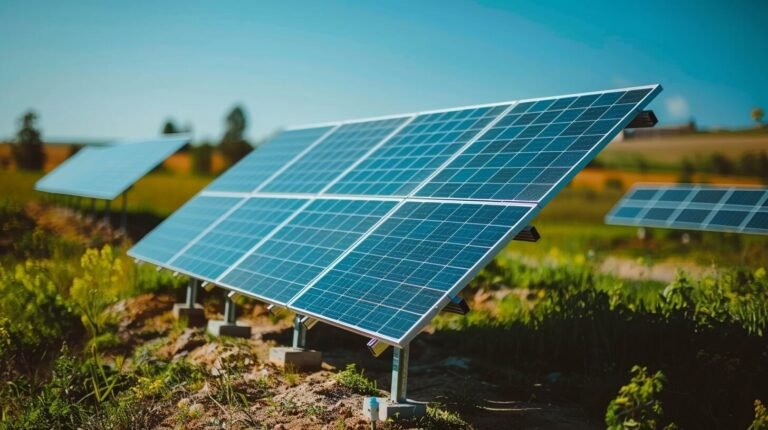Solar Light Charging Time Calculator
How It Works
- Inputs:
- Battery capacity (in Wh), solar panel wattage (W), average sunlight hours, battery efficiency, and solar efficiency.
- Calculations:
- Effective Solar Panel Output: Solar Output (Wh/day)=Solar Panel Size (W)×Sunlight Hours×Solar Efficiency\text{Solar Output (Wh/day)} = \text{Solar Panel Size (W)} \times \text{Sunlight Hours} \times \text{Solar Efficiency}Solar Output (Wh/day)=Solar Panel Size (W)×Sunlight Hours×Solar Efficiency
- Charging Time: Charging Time (days)=Battery Capacity (Wh)Battery Efficiency×Solar Output (Wh/day)\text{Charging Time (days)} = \frac{\text{Battery Capacity (Wh)}}{\text{Battery Efficiency} \times \text{Solar Output (Wh/day)}}Charging Time (days)=Battery Efficiency×Solar Output (Wh/day)Battery Capacity (Wh)
- Outputs:
- Display the charging time in days.

Solar Light Charging Time Calculator: Optimize Your Solar Light Performance (2024)
Looking to get the most out of your solar lights? You’re not alone! Did you know that inefficient solar charging can reduce your solar lights’ lifespan by up to 40%? As sustainable lighting becomes increasingly popular, understanding the precise charging time for your solar lights is crucial for optimal performance.
I’ve created this comprehensive guide and interactive calculator to help you determine the exact charging duration needed for your solar lights.
Above you’ll find our easy-to-use solar charging calculator. Simply input your battery capacity, solar panel output, and sunlight intensity to get an accurate estimate of charging time.
But let’s dive deeper into understanding how to make the most of your solar lighting system!
Understanding Solar Light Charging Basics
Solar lighting might seem straightforward, but there’s fascinating technology at work behind those glowing lights in your garden.
At its core, a solar light consists of three main components working in harmony: the solar panel, battery, and charge controller.
The solar panel contains photovoltaic cells that convert sunlight into electrical energy. Think of these cells as tiny power plants, harvesting energy from the sun’s rays throughout the day.
The charge controller acts as the system’s brain, regulating the flow of electricity to prevent overcharging and battery damage. Finally, the battery stores this energy for use when darkness falls.
Many people believe that solar lights only charge on bright, sunny days, but this isn’t entirely true. While direct sunlight provides optimal charging conditions, solar panels can still generate power on cloudy days – they’re just less efficient.
How to Use the Solar Light Charging Calculator
Our calculator above makes it simple to determine your solar light’s charging time. Here’s how to get the most accurate results:
First, locate your battery’s capacity, typically measured in milliamp-hours (mAh). You’ll usually find this information on the battery itself or in your solar light’s manual.
Next, input the solar panel output, which is measured in milliamps (mA). Finally, estimate the sunlight intensity based on weather conditions – use 100% for direct sunlight on a clear day, and adjust downward for cloudy conditions.
The calculator takes into account charging inefficiencies and provides you with a realistic estimate of how long it will take to fully charge your solar light’s battery.
Factors Affecting Solar Charging Time
Several key factors influence how quickly your solar lights charge.
Location plays a crucial role – for instance, solar lights in Arizona will typically charge faster than identical units in Seattle due to differences in sun exposure.
Seasonal changes also significantly impact charging times, with shorter days in winter requiring more strategic placement.
Temperature is another often-overlooked factor. While you might think hotter is better for solar charging, extremely high temperatures can reduce charging efficiency.
The sweet spot for most solar panels is between 59°F and 95°F (15°C to 35°C).
Tips to Optimize Solar Light Charging
Want to maximize your solar light’s performance? Here are some proven optimization strategies:
For optimal charging, position your solar lights where they’ll receive maximum sunlight during peak hours (typically 10 AM to 2 PM). Clean your solar panels regularly – even a thin layer of dust can reduce efficiency by 10%. During winter months, consider adjusting the angle of your solar panels to compensate for the sun’s lower position in the sky.
Regular maintenance is crucial. Check for any debris or snow covering the solar panel, and trim back any overhanging branches that might cast shadows. If you notice significantly reduced performance, it might be time to replace the batteries – most rechargeable batteries in solar lights last 1-2 years with proper care.
Understanding Solar Light Battery Types
Not all solar light batteries are created equal. The most common types are Nickel-Metal Hydride (NiMH) and Lithium-Ion (Li-ion).
NiMH batteries are more affordable and work well in most conditions, but Li-ion batteries offer better performance in cold weather and typically last longer.
When selecting replacement batteries, always match the capacity (mAh) and voltage to your original battery.
Using a higher-capacity battery won’t necessarily result in longer operating times if your solar panel can’t provide sufficient charging current.
The battery’s capacity significantly affects both charging time and how long your lights will operate at night.
A higher-capacity battery takes longer to charge but provides longer illumination time. For most home applications, a 2000-3000mAh battery provides a good balance between charging time and operation duration.
Conclusion
Understanding your solar lights’ charging requirements doesn’t have to be complicated! With our calculator and optimization tips, you can ensure your solar lights perform at their best year-round.
Remember to regularly check your charging times and adjust placement as seasons change. Take advantage of our calculator above to optimize your solar lighting setup, and implement these recommendations to enjoy bright, reliable solar lighting throughout the year.
Keep in mind that while the calculator provides a good estimate, real-world conditions can vary. Monitor your lights’ performance and adjust your setup accordingly.
With proper care and optimization, your solar lights can provide years of reliable, sustainable illumination for your outdoor spaces.



